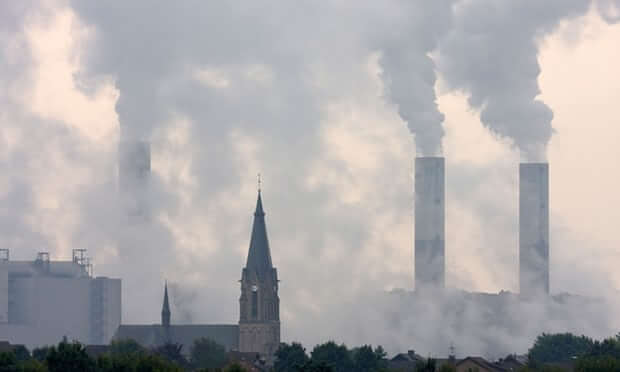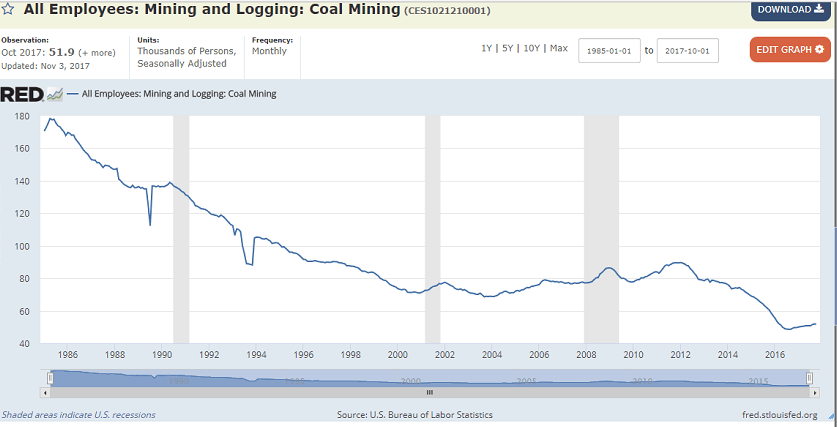There’s Nothing Controversial About Coal-Fired Power Plants

“Astounded?” Oh come on. Who’s going to believe that, after all these years, there’s something I could possibly write or say that would astound you.
Seriously, there are really only two points to be made here:
1. The overall trend in coal, at least in the U.S, thank God, is plant recommissioning. Here’s the Brookings Institute’s report on the subject. According to the U.S. Bureau of Labor, there are fewer than 52,000 employed in the entire country, a tiny fraction of the work force.
As we view the chart below, we acknowledge that yes, the president’s lifting of certain environmental regulations has indeed resulted in that bump of about 1500 jobs visible at the far right; celebrate that if you wish, but I think anyone would admit that the trend here shows that employment in the industry is moribund.

According to Physicians for Social Responsibility, which is part of Physicians for the Prevention of Nuclear War (1985 Nobel Peace Prize laureate): Coal pollutants affect all major body organ systems and contribute to four of the five leading causes of mortality in the U.S.: heart disease, cancer, stroke, and chronic lower respiratory diseases.
- Respiratory Effects: Air pollutants produced by coal combustion act on the respiratory system, contributing to serious health effects including asthma, lung disease and lung cancer, and adversely affect normal lung development in children.
- Cardiovascular Effects: Pollutants produced by coal combustion lead to cardiovascular disease, such as arterial occlusion (artery blockages, leading to heart attacks) and infarct formation (tissue death due to oxygen deprivation, leading to permanent heart damage), as well as cardiac arrhythmias and congestive heart failure. Exposure to chronic air pollution over many years increases cardiovascular mortality.
- Nervous System Effects: Studies show a correlation between coal-related air pollutants and stroke. Coal pollutants also act on the nervous system to cause loss of intellectual capacity, primarily through mercury. Researchers estimate that between 317,000 and 631,000 children are born in the U.S. each year with blood mercury levels high enough to reduce IQ scores and cause lifelong loss of intelligence.
I chose the word “controversial” to use in the title of this post carefully, as it’s a suggestion that both good and bad things could be said about a certain subject. To say that coal isn’t controversial is to remind us that there is really only one side of the argument: we need to discontinue its use as quickly as we possibly can, without causing even worse problems, e.g., power outages in winter from which people freeze to death.
In this respect, I liken the defense of coal to an argument on behalf of genocide or slavery: there is none.

Craig,
Like all industries, there is no denying Coal has undesirable aspects. This is true of all industrial progress.
However, focusing on (and exaggerating) the negatives of all human industrial progress without including the essential benefits is disingenuous at best and at worst dishonest.
I say dishonest because I have never read a single word you have written concerning the numerous negative environmental aspects of Solar and Wind Power generation.
Why ?
If this lack of concern was created by ignorance or lack of information, that could be excused, but when, as I suspect, it’s simply to not disturb an ideological/political agenda, well I hope you’ll forgive me for being skeptical of the integrity of such silence.
Why do you persist in publishing these irrelevant and inaccurate graphs? I provided the disclaimer from the US Bureau Of Statistic explaining why such graphs are inaccurate if taken out of context, byet you still persist, why?
Since the election of President trump the US coal industry has directly or indirectly, increased employment by over 100,000 jobs in less than 1 year. These are all American jobs, many created in export. Not short term jobs reliant on 90 % of the product being produced abroad and only installed with local labor, but US jobs where the economic activity created benefits the local community.
Coal still provides 33 % of US electricity. That’s the hard core energy needed to maintain a modern industrial economy.
Without a heavy commitment to nuclear power generation, Coal is indispensable .
But there’s a lot we can do to retain the benefits of Coal while mitigating an reducing the negatives. Pretending that if we all just wish hard enough the nasty coal industry will go away and be replaced by rainbows and pixie dust, just wont happen !
It’s true that I don’t a lot on the environmentally negative aspects of RE. But there are:
a) References to these issues in each of the chapters on “technology” in “Renewable Energy–Facts and Fantasies” — http://www.2greenenergy.com/renewable-energy-facts-fantasies-ebook/
b) Several videos on the “pros and cons” of solar, wind etc. in the “truth” section of the website: http://www.2greenenergy.com/renewable-energy-basic-concepts/
c) Numerous blog posts where I discuss the EROI associated with solar and wind. http://www.2greenenergy.com/?s=eroi&submit=Go I.e., it’s not infinite; there is no such thing as a free lunch, as they say. It’s true.
Craig,
Well, it was very brave and honest of you cite as your reference a five year old video of your own predictions.
You can be forgiven for not anticipating the massive rise of North American fossil fuel resources, breathing new life into the US economy and making oil and gas relatively cheap and plentiful. Naturally, you couldn’t have known that fracking would lead to a real challenger for economic coal consumption.
Like most people, in your enthusiasm for solar, you never considered the problems associated with the disposal of redundant solar panels, or the dreadful conditions employed to lower the cost of solar technology by the PRC. Just a fans of “lithium” Batteries avoid mentioning the most important element in the battery is actually cobalt.
Cobalt is really, really toxic and 90 % of cobalt is mined in appalling conditions in the Congo.
I guess you could be forgiven for believing solar panels could be ‘recycled’ with ease.
Recycling is the elephant in the room no solar advocate wants to mention. Because of the toxic components in the average panels, and the impossibility of recycling, we are creating an environmental time bomb that makes environmental problems associated with coal insignificant and almost benign.
Solar panels create 300 times more toxic waste per unit of energy than nuclear power plants. Discarded solar panels contain dangerous elements such as lead, chromium, and cadmium.
India, China and other nations solve the disposal problem by burning the panels in the hope of salvaging copper wire. The resulting smoke contains more toxic carcinogenic and teratogenic (birth defect-causing) fumes from a single panel, than 10,000 tons of coal !
Nor 7 years ago, could you be expected to know how quickly quartz mining would expand to accommodate the solar panel industry.
Solar energy can be generated using a variety of technologies, but 94% solar cells are quartz. Quartz mining is 1000 times more dangerous to miners than coal ! (including silicosis).
Refining turns quartz into metallurgical-grade silicon,needs giant high temperature furnaces using a vast amount of energy, guess what powers these furnaces ?
That’s right, 86% are coal fired !
Naturally, the process pumps a huge amount of carbon dioxide and sulfur dioxide— into the environment along with a whole range of other nasties
From there, the refinement process involves combining hydrochloric acid with metallurgical-grade silicon to make trichlorosilanes. Trichlorosilanes react with added hydrogen, producing polysilicon along with liquid silicon tetrachloride(three or four tons of silicon tetrachloride for every ton of polysilicon).
Oh, but hey there’s good news on the way, thin-film solar cells can be produced from even more super toxic substances like cadmium telluride, copper indium gallium selenide (CIGS). and cadmium sulfide.
Cadmium is a heavy metal, w both a carcinogen and a genotoxin, meaning that it can cause inheritable mutations.
The list goes on and on. It’s possible to argue that solar is far more environmentally harmful than Solar on a rational scientific and economic basis.
But what’s the point ?
You stopped listening a long time ago ! I’m not opposed to solar energy technology, but as taxpayers and environmentalists, perhaps we should be putting our dreams and political ideologies aside and evaluate what sort of technology our tax dollars are really buying.
That’s what I mean by being open minded, it’s (short for it is) easy become a one eyed supporter without knowing the real facts.
This doesn’t mean we should suddenly demonize solar energy, just work harder creating less problematic solar panels. Just as we shouldn’t demonize the coal industry, just work harder to develop technologies to mitigate or make us of negative emissions.
Craig, here’s the real challenge ?
In your heart of hearts, if it could be scientifically proven than the waste from Solar was more pollutant over 30 years, than the negatives of Coal, would you be prepared to change your mind ? Or even listen and consider ?
I ask in all sincerity, knowing how hard giving up a cherished ideology.
“It’s possible to argue that solar is far more environmentally harmful than Solar on a rational scientific and economic basis.”
I’m unsure what you intended to say there, but I’m certain readers would be interested in a solid, well-referenced, comparison of environmental impacts from specific CSP and PV installations that feed us energy from modern sunlight, and those of specific fossil sources.